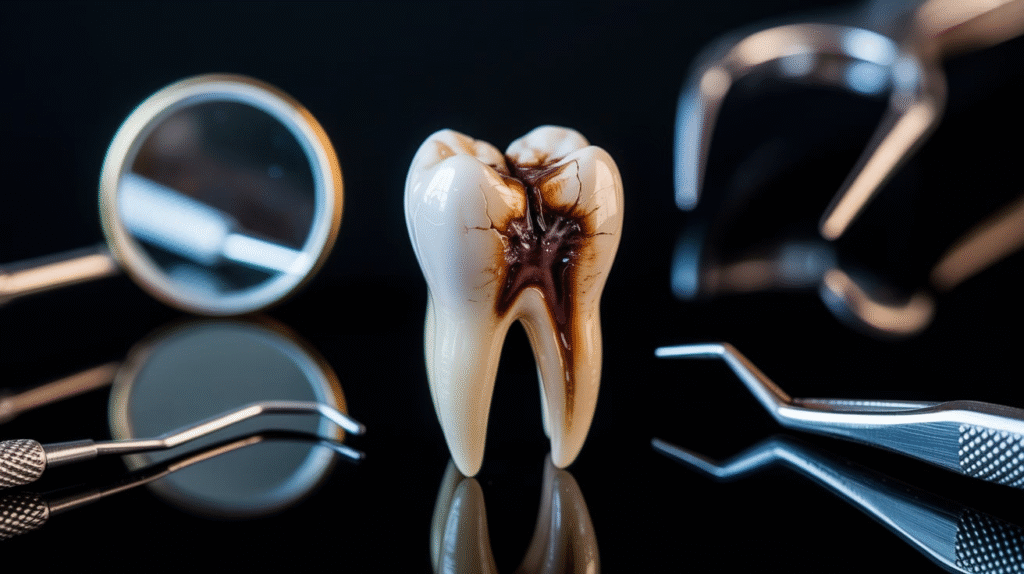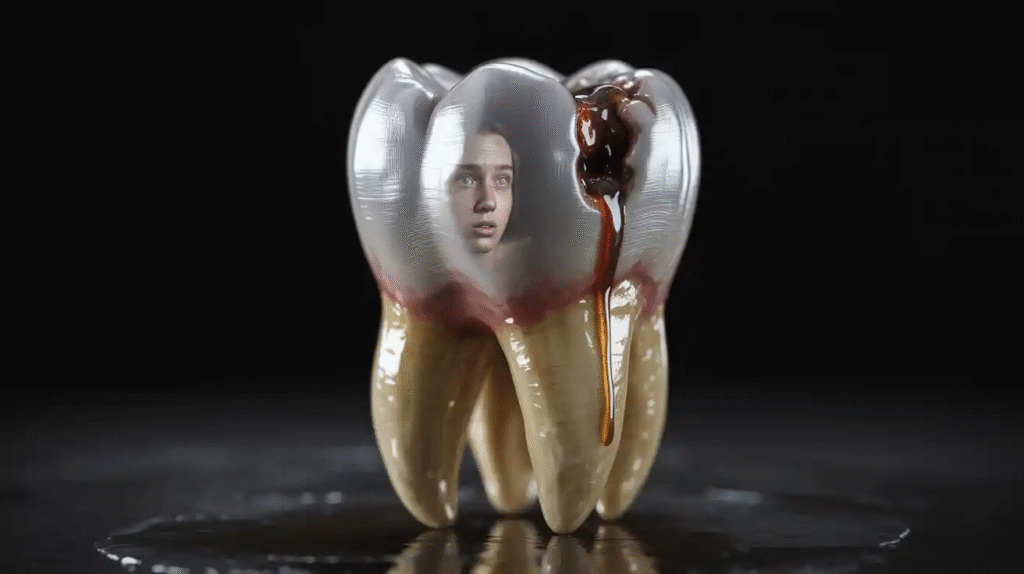A few years ago, I ignored a severe toothache thinking it was nothing serious. Days later, I had facial swelling, high fever, and unbearable pain. I ended up in the ER with a diagnosis that shook me—a spreading tooth infection. I was lucky. Some people aren’t.
In this article, I’ll break down how fast a tooth infection can become life-threatening, what signs to watch for, and how you can protect yourself.
Table of Contents
1. What Is a Tooth Infection?

A dental abscess, another name for a tooth infection, is a bacterial accumulation of pus. It may appear in several areas of the gums or tooth:
- Periapical abscess (tip of the tooth root)
- Periodontal abscess (gum next to the root)
- Gingival abscess (surface of the gum)
This illness can swiftly progress to the jaw, neck, and even the brain if left untreated.
2. What Causes Tooth Infections?

Tooth infections start when bacteria enter through:
- Untreated cavities
- Cracked or broken teeth
- Advanced gum disease
- Failed dental work
- Poor oral hygiene
The infection starts when bacteria get to the inner tooth or the gums around it.
3. Signs of a Spreading Tooth Infection
Early Symptoms:
- Toothache or throbbing pain
- Swelling of the gums or face
- Red, inflamed gums
- Bad breath or foul taste
Dangerous Signs of Infection Spread:
- Fever and chills
- Jaw pain or tightness
- Swollen lymph nodes
- Difficulty opening your mouth
- Trouble breathing or swallowing
These could indicate a dental emergency—the infection progressing.
4. How Fast Can a Tooth Infection Spread?

A dental abscess can spread within 24–72 hours if not treated.
Bacteria can move:
- Into the jawbone
- Through facial tissues into the sinuses
- Into the bloodstream (causing sepsis)
- To the brain (causing an abscess)
Speed depends on:
- Your immune system
- Overall health
- The severity of the infection
5. Can a Tooth Infection Really Kill You?
Indeed. Although rare, untreated dental infections can be lethal. When bacteria from the infected tooth enter your bloodstream or travel to vital organs, it becomes life-threatening.
Fatal Complications Include:
- Sepsis (system-wide infection)
- Ludwig’s Angina (airway-blocking throat infection)
- Brain abscess
- Endocarditis (heart infection)
6. How Long Until a Tooth Infection Becomes Fatal?
In just five to ten days, a serious tooth infection can become lethal if treatment is not received.
In rare but extreme cases, people have died within 72 hours from systemic infection.
Key Timeline:
- Day 1–2: Localized toothache, mild swelling
- Day 3–5: Pus builds up, facial swelling increases
- Day 6–10: Infection spreads to neck, bloodstream, or brain
- After Day 10: Possible systemic failure if untreated
When a Tooth Infection Requires Hospitalization
Seek emergency care immediately if you experience:
- Trouble breathing or swallowing
- Rapid facial swelling
- Fever above 101°F (38.3°C)
- Confusion or dizziness
- Chest pain or irregular heartbeat
- Vision changes
These are signs that the infection may have entered your bloodstream or vital organs.
8. Risk Factors: Who’s Most at Risk?
The following factors make you more susceptible to potentially fatal oral infections:
- Have a weakened immune system (HIV, cancer, diabetes)
- Are a smoker
- Have chronic illnesses
- Take medications like immunosuppressants
- Avoid regular dental visits
9. How Sepsis from a Tooth Infection Occurs
Sepsis is the body’s deadly response to infection. When bacteria from your infected tooth get into your bloodstream, it occurs.
Signs of Sepsis:
- Rapid heart rate
- Confusion or foggy thinking
- High or very low temperature
- Difficulty breathing
- Low blood pressure
Sepsis needs immediate hospital treatment with IV antibiotics and often ICU care.
10. Treatment Options for Infected Teeth
1. Antibiotics – First line to kill infection
2. Drainage – Dentist may drain the abscess
3. Root Canal – To remove infected tissue
4. Tooth Extraction: In the event that the tooth cannot be preserved
5. Hospitalization – For advanced infections
11. How to Prevent Dangerous Tooth Infections
- Brush and floss twice daily
- Visit the dentist every 6 months
- Avoid smoking and sugar-rich diets
- Get cavities and cracks treated early
- Finish all prescribed antibiotics
- Use antibacterial mouthwash as recommended
12. Real-Life Stories
James, 32 – Delayed Dentist Visit
He ignored his toothache for 10 days. The illness had spread by the time he entered. He had sepsis and was hospitalized for six days. He survived, but lost 2 teeth.
Maya, 45 – Took Quick Action
She felt swelling and went to urgent care that same day. With antibiotics and a root canal, she made a full recovery in 5 days.
13. Expert Tips from Dentists
“Fever and a swollen face are warning signs; don’t wait.” Dr. Lisa G., DDS
“Tooth infections kill more than people think. If you feel worse, go to the ER.” – Dr. Anthony S., Endodontist
“Painkillers won’t stop the infection. Antibiotics and drainage will.” – Dr. Maria K., General Dentist
14. Oral Health and Your Body
Oral infections can affect your:
- Heart (endocarditis)
- Brain (abscess)
- Lungs (aspiration pneumonia)
- Kidneys (if bacteria spreads)
Dental health is not just cosmetic—it’s critical to your whole-body health.
15. Final Thoughts
At first, tooth infections might appear to be a minor issue. However, they can develop into life-threatening situations if ignored. Don’t wait for the pain to go away. Don’t risk it.
If you’re asking “how long until a tooth infection kills you?” — you’re already cutting it too close.
Visit your dentist.
Don’t self-medicate.
Watch for emergency symptoms.
Take your oral health seriously.
FAQs
What does the lift safety sign mean?
It shows the lift has passed a recent inspection and is safe to use. It includes dates, load limits, and who approved it.
Where is the lift safety sign usually located?
Inside the lift, near the control panel, or on the wall near the entrance. It should be clearly visible.
What if the sign is missing or expired?
Report it to building management and refrain from using the elevator. An expired or missing sign means it may not be safe.
How often are lifts inspected?
Typically every 6 to 12 months, depending on local laws. High-traffic buildings may need more frequent checks.
Who is responsible for putting up the sign?
Building owners or property managers are legally required to inspect the lift and display a valid safety sign.
Is it illegal to use a lift without a safety sign?
In many countries, yes. Using or operating an uncertified lift can lead to fines or legal action.
Can I trust a lift just because it looks new?
No. Even new lifts need inspection. Always check the safety sign—it’s the only proof it’s certified safe.



